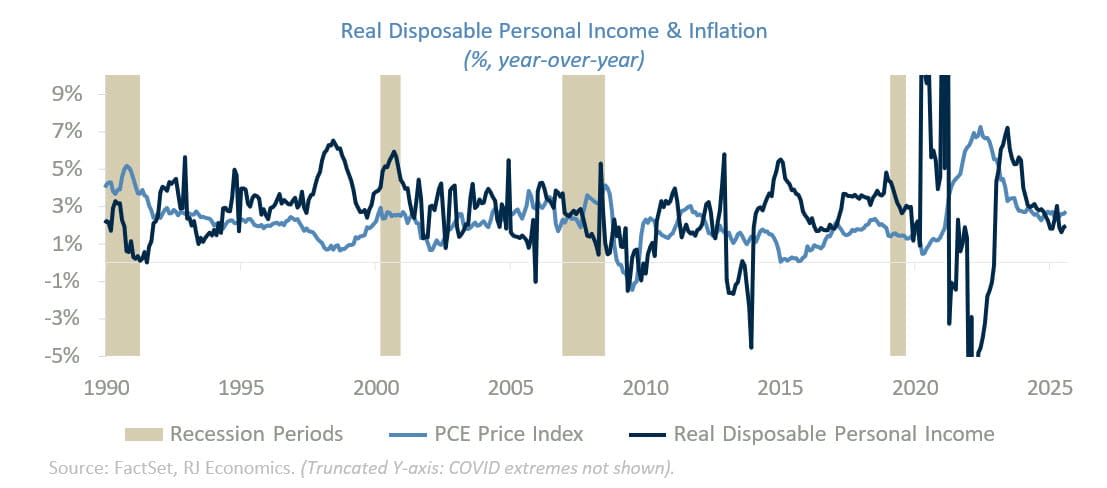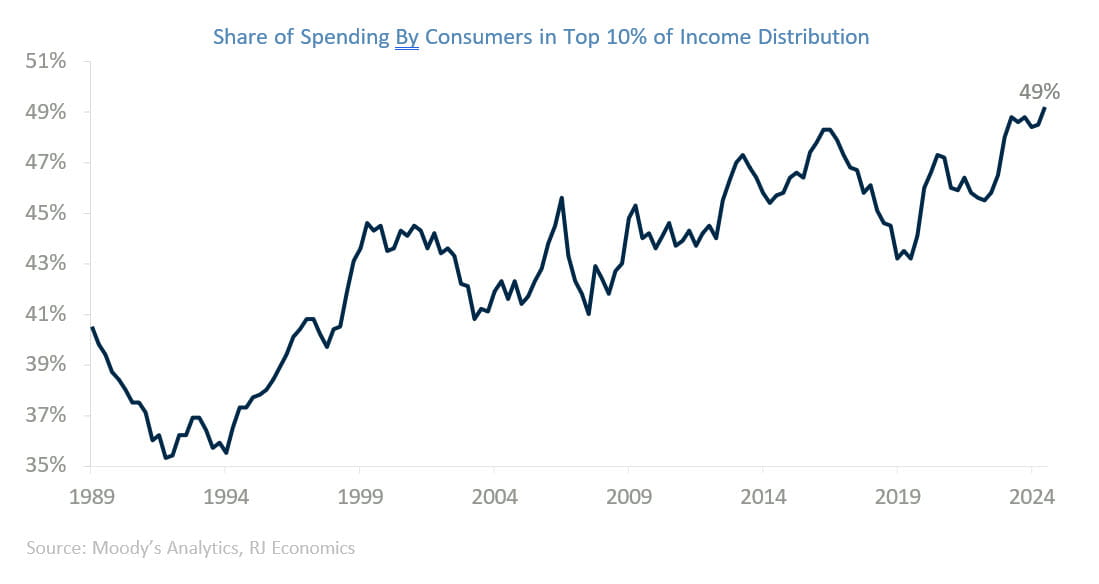New shocks, different strokes
- 10.24.25
- Economy & Policy
- Commentary
Chief Economist Eugenio J. Alemán discusses current economic conditions.
Yes, this time is different than during the recovery from the pandemic recession. The most important difference was that Americans were awash with cash accumulated during the pandemic, as the U.S. government transferred insane amounts of money to households and businesses in an attempt to minimize the negative effects from the crisis. That accumulation of cash, or what was called ‘excess savings,’ at a time when there were very few spending alternatives to use those excess savings, was one of the reasons why inflation increased so much and lasted longer than expected. The Federal Reserve’s (Fed) argument that inflation was temporary was correct but the timing of ‘temporary’ was longer and more extensive across sectors than what Fed officials had expected.
Excess availability of cash in the hands of households and firms made the inflation problem more difficult to solve than the Fed had originally estimated. Even increasing the federal funds rate to 5.25%-5.50% was not enough to entice Americans to keep those excess savings earning interest rather than using them to go on a spending spree without any regard for the future.
At the same time, the recovery from the pandemic was very positive for lower-income workers. Firms needed to entice those more impacted by the pandemic to come back to the labor force by offering higher wages than workers who were not or less affected by the pandemic.
Meanwhile, as we have argued before, high interest rates did not have much of an effect on non-residential investment at a time when the U.S. federal government passed the IRA and the CHIPS act, which incentivized investment in several sectors of the economy and made such investments relatively immune to high interest rates.
All these factors combined created an environment that supported economic growth even as the Fed continued to increase interest rates.
Today, despite facing several new shocks to the economy—namely tariff and immigration shocks—the economy, though weakening, has continued to expand. But conditions are very different than during the recovery from the pandemic recession. The economy is being driven by AI investment and the gains in stock market wealth, which are disproportionally benefiting high-income individuals. Most Americans, however, are struggling, as inflation is accelerating and income and employment growth are weakening.
There is very little ability for households to continue to push prices higher today compared to during the recovery from the pandemic. Real disposable personal income is growing slowly (see graph on the previous page), which means that in order to consume more of one good, consumers need to reduce consumption of other goods—giving inflation very little room to stay higher for longer.
Although we are expecting inflation to continue to move higher during the next year, we also expect it to come back down after the initial tariff impact is out of the system. This does not mean that the price level is going to come down, which is what almost everybody would have liked, i.e., for the price of goods and services to come down. What it means is that the rate of increase of prices is going to slow down, i.e., the rate of inflation, and approach the target sought by the Fed over the next several years.
Still, the Fed will have to tread lightly in this environment, especially if the economy starts to recover during the first half of 2026, because it does not want to encourage a de-anchoring of inflation expectations that could threaten the achievement of the inflation target. We expect the rebound in demand to be fueled by temporary stimulus from tax cuts, refunds, and accelerated depreciation under the One Big Beautiful Bill (OBBB). If this is the case, the Fed will remain ‘data dependent.’
Economic and market conditions are subject to change.
Opinions are those of Investment Strategy and not necessarily those of Raymond James and are subject to change without notice. The information has been obtained from sources considered to be reliable, but we do not guarantee that the foregoing material is accurate or complete. There is no assurance any of the trends mentioned will continue or forecasts will occur. Past performance may not be indicative of future results.
Consumer Price Index is a measure of inflation compiled by the US Bureau of Labor Statistics. Currencies investing is generally considered speculative because of the significant potential for investment loss. Their markets are likely to be volatile and there may be sharp price fluctuations even during periods when prices overall are rising.
Consumer Sentiment is a consumer confidence index published monthly by the University of Michigan. The index is normalized to have a value of 100 in the first quarter of 1966. Each month at least 500 telephone interviews are conducted of a contiguous United States sample.
Personal Consumption Expenditures Price Index (PCE): The PCE is a measure of the prices that people living in the United States, or those buying on their behalf, pay for goods and services. The change in the PCE price index is known for capturing inflation (or deflation) across a wide range of consumer expenses and reflecting changes in consumer behavior.
The Consumer Confidence Index (CCI) is a survey, administered by The Conference Board, that measures how optimistic or pessimistic consumers are regarding their expected financial situation. A value above 100 signals a boost in the consumers’ confidence towards the future economic situation, as a consequence of which they are less prone to save, and more inclined to consume. The opposite applies to values under 100.
Certified Financial Planner Board of Standards Center for Financial Planning, Inc. owns and licenses the certification marks CFP®, CERTIFIED FINANCIAL PLANNER®, and CFP® (with plaque design) in the United States to Certified Financial Planner Board of Standards, Inc., which authorizes individuals who successfully complete the organization’s initial and ongoing certification requirements to use the certification marks.
Links are being provided for information purposes only. Raymond James is not affiliated with and does not endorse, authorize or sponsor any of the listed websites or their respective sponsors. Raymond James is not responsible for the content of any website or the collection or use of information regarding any website's users and/or members.
GDP Price Index: A measure of inflation in the prices of goods and services produced in the United States. The gross domestic product price index includes the prices of U.S. goods and services exported to other countries. The prices that Americans pay for imports aren't part of this index.
Employment cost Index: The Employment Cost Index (ECI) measures the change in the hourly labor cost to employers over time. The ECI uses a fixed “basket” of labor to produce a pure cost change, free from the effects of workers moving between occupations and industries and includes both the cost of wages and salaries and the cost of benefits.
US Dollar Index: The US Dollar Index is an index of the value of the United States dollar relative to a basket of foreign currencies, often referred to as a basket of U.S. trade partners' currencies. The Index goes up when the U.S. dollar gains "strength" when compared to other currencies.
The FHFA HPI is a broad measure of the movement of single-family house prices. The FHFA HPI is a weighted, repeat- sales index, meaning that it measures average price changes in repeat sales or refinancings on the same properties.
Import Price Index: The import price index measure price changes in goods or services purchased from abroad by U.S. residents (imports) and sold to foreign buyers (exports). The indexes are updated once a month by the Bureau of Labor Statistics (BLS) International Price Program (IPP).
ISM Services PMI Index: The Institute of Supply Management (ISM) Non-Manufacturing Purchasing Managers' Index (PMI) (also known as the ISM Services PMI) report on Business, a composite index is calculated as an indicator of the overall economic condition for the non-manufacturing sector.
The ISM Manufacturing Index: The GDP Now Institute of Supply Management (ISM) Manufacturing Measures the health of the manufacturing sector by surveying purchasing managers at manufacturing firms. The survey asks about current business conditions and expectations for the future, including new orders, inventories, employment, and deliveries.
Consumer Price Index (CPI) A consumer price index is a price index, the price of a weighted average market basket of consumer goods and services purchased by households.
Producer Price Index: A producer price index (PPI) is a price index that measures the average changes in prices received by domestic producers for their output.
Industrial production: Industrial production is a measure of output of the industrial sector of the economy. The industrial sector includes manufacturing, mining, and utilities. Although these sectors contribute only a small portion of gross domestic product, they are highly sensitive to interest rates and consumer demand.
The NAHB/Wells Fargo Housing Opportunity Index (HOI) for a given area is defined as the share of homes sold in that area that would have been affordable to a family earning the local median income, based on standard mortgage underwriting criteria.
Conference Board Coincident Economic Index: The Composite Index of Coincident Indicators is an index published by the Conference Board that provides a broad-based measurement of current economic conditions, helping economists, investors, and public policymakers to determine which phase of the business cycle the economy is currently experiencing.
Conference Board Lagging Economic Index: The Composite Index of Lagging Indicators is an index published monthly by the Conference Board, used to confirm and assess the direction of the economy's movements over recent months.
New Export Index: The PMI New export orders index allows us to track international demand for a country's goods and services on a timely, monthly, basis.
Gold is subject to the special risks associated with investing in precious metals, including but not limited to: price may be subject to wide fluctuation; the market is relatively limited; the sources are concentrated in countries that have the potential for instability; and the market is unregulated.
The Conference Board Leading Economic Index: Intended to forecast future economic activity, it is calculated from the values of ten key variables.
Source: FactSet, data as of 10/17/2025



